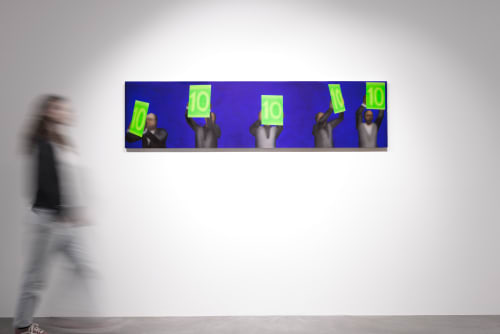One thing I've loved doing in 3D video games is approaching other characters or objects until I can get no closer. I would then stare at my screen for a long time. As I approach, the details lose clarity, the "fine" becomes "raw," the sharpness turns into blurriness (the opposite experience of real-world observations), and my interest shifts away from what it is. I really want to witness or prove that this cannot be real. I use the blurriness or the ridiculousness (mapping rendering flaws) to prove that they are made by humans- for a child, that is a safe conclusion. - Gao Hang, 2024
This exhibition, interweaving Gao's reflections with the seminal thoughts of French philosopher Jean Baudrillard on Simulation and Simulacra, presents a series of works that delve into the artist's personal and generational encounter with the digital realm. Through animated characters reminiscent of 1990s computer games, Gao articulates a complex narrative on identity, reality, and the digital frontier. His works, often not fully rendered and bearing titles like "You see, you are also simulated buddy," echo Baudrillard's assertions on the hyperreal - a world in which simulations do not merely represent reality but come to supplant it.
Gao's artistic inquiry aligns with Baudrillard's notion that in the hyperreal, the distinction between the real and the simulation blurs, leading us to question the authenticity of our experiences. Gao's fascination with the digital world's 'humanness' - its blurriness, rendering flaws, and the inherent 'ridiculousness' - serves as a metaphor for the quest to find authenticity in a simulated existence. His work suggests that this digital archaeology, much like the discovery of cave paintings, reveals not just the birth of a new civilization but the inherent human desire to find meaning and reality within simulations.
Drawing from art history, Gao positions himself and his work within a lineage of artists who have abstracted their surroundings to question and interpret their era. His approach resonates with Baudrillard's exploration of simulacra - the copies for which no original has ever existed. Through his lens, Gao's works become artifacts of a civilization at the threshold of the real and the simulated, offering a poignant commentary on our digital age.
Gao's philosophical musings, informed by the ideas of Nick Bostrom and the experiments of John B. Calhoun, extend the exhibition's narrative to the broader questions of existence and the nature of humanity. His work prompts us to consider the possibility that our reality is but a simulation, a theme that ties back to Baudrillard's challenges to our perceptions of reality.
"You See? You are also simulated" is more than an exhibition; it is a philosophical journey that bridges art history and digital culture, inviting viewers to explore the depths of their perceptions and the constructs of their realities. Through Gao Hang's eyes, we are encouraged to confront the hyperreal, to find beauty in the blurred lines of our digital existence, and to question the very fabric of our simulated lives.


